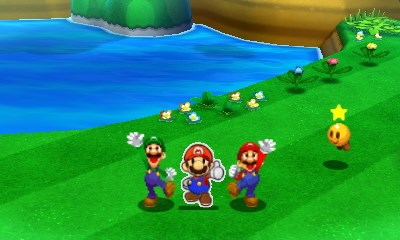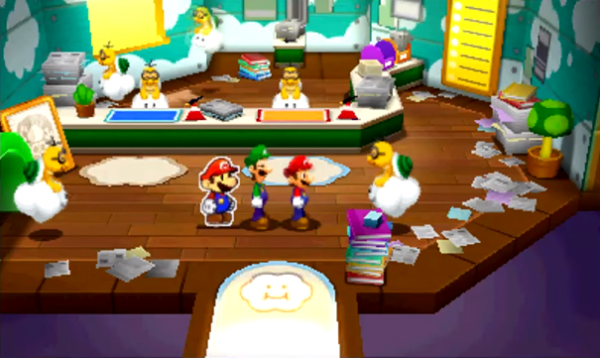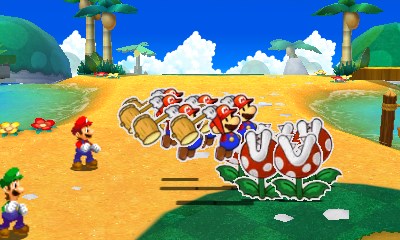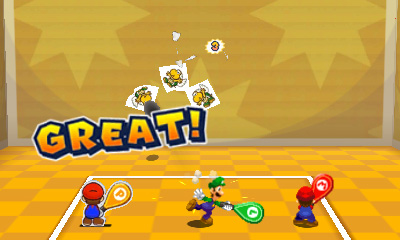Publisher: Nintendo
Developer: AlphaDream
Medium: Cartridge
Players: 1
Online: None
ESRB: E10+ – Everyone 10+
In some ways, Mario & Luigi: Paper Jam is a wake-up call after the half-asleep Mario & Luigi: Dream Team. In others, it’s the missing story that seems to have detached from Paper Mario: Sticker Star. Regardless of which issue it could resolve for either series, Nintendo has one thing drawing fans from both camps: a game for both camps. It’s easy to wonder how that turned out, and in search of an answer we took to juggling two franchises in a single review.

To answer the most and least obvious question, Mario & Luigi: Paper Jam is an RPG largely in the style of the Mario & Luigi games. Developer AlphaDream committed to Mario & Luigi’s active turn-based battle system for the game’s primary form of combat and built off that foundation to flesh it out with opportunities provided by a player party of three — rather than Mario & Luigi’s traditional two.
It’s also likely that the developer rationalized the setting would be more appropriate in Mario and Luigi’s 3D world, rather than the step back in dimensions that Paper Mario’s world would qualify. Since it’s likely that many other careful and thoughtful decisions went into comfortably interlocking two successful RPGs, we’ll skip speculating any further and decide that it’s not worth thinking about except that the title reads nicely. Mario & Luigi: Paper Jam. It says everything anyone who’s interested is going to care to know, and it’s starting to feel like you’re not very interested in sticking around for how this sentence is going to turn out.

Story-wise, AlphaDream keeps things simple, taking the book we’ve known Paper Mario’s world to live within and placing it in a library atop Princess Peach’s castle. Luigi happens upon it, accidentally freeing every bit of menace and doubling the amount of Bowser in one world — not to mention the cleanup effort that our heroes will need to go through. Luckily, Paper Mario’s somewhere, and with twice the Mario, there’s half as much work, meaning that everything basically balances out to a traditional “get Bowser” plot. While story isn’t the game’s strong suit, there’s more entertaining writing in Paper Jam than either series’ preceding 3DS game felt like it had, and even more importantly is that the pacing is wound nice and tight.
Pacing is probably Paper Jam’s most valuable asset, as it applies almost universally to the game; battles and play out quickly, level design is nice and compact, puzzles aren’t convoluted, and even with succinct cutscenes there’s the ability to hold the R trigger to speed them along. There’s also not a trace of grinding, meaning that players will find themselves at a comfortable level so long as they clear the field of most or all enemies.

One other benefit of a series mashup is that in this point of both franchises, players interested in a game combining them are also familiar with how to play either. This means that where most Nintendo games would normally provide a careful tutorial for introducing mechanics, Paper Jam puts an asterisk next to any new element by having Starlow pop up and inform players that an optional demo and practice menu is available to learn the ropes before continuing. Nintendo has been expediting their tutorials a lot lately, and this feels like a great solution to handling a span of players between newcomers and series veterans.
In combat, the Bros Attacks have returned to feature action-based sequences with Mario and Luigi combining their powers for grandiose attacks. Paper Mario’s inclusion adds Trio Attacks to the mix, which employ all three characters in Paper Mario-themed microgames in the spirit of Bros Attacks. Some of these special attacks seem more useful, making others seem not-so-special, and while most are fun to use, it became that a select few generally did the job. Interestingly, some of the more expensive attacks turned out to be ones frequently benched.

New to the series are Battle Cards, which are effectively buffs and abilities that can be used without taking up player actions. These are displayed on the lower screen, shuffled from a deck of ten in an active hand of up to three. The general idea is that players can turn to Battle Cards as freebies for health, defense, or an extra attack, while others provide post-battle bonuses such as XP or extra coins. This sounds like a bit overpowered, and that would be the case had they not been wrangled in with the new Star Points resource, which determines the cost of a card and whether or not the player can afford to use it. While these cards add an additional layer to the game, I found myself turning to them to squeeze out as much XP as possible.
Lastly are the Papercraft battles, in which the player drives a gargantuan papercraft character with which they’ll charge and toss at other enemies on the playing field. Make no mistake, the field is almost literally a football-size field of space due to the scope of these structures. Players must balance their health and energy (the latter which is recharged by keeping rhythm on a musical platform where the heroes are cheered on) while maneuvering the battlefield to destroy enemies, and subsequently a final boss in the area.

Amazingly, this whole concept is handled rather well and comes off as fun and interesting where it could have easily been boring and tedious. It’s not perfect, and you’ll sometimes find yourself waiting for enemies to provide a window of opportunity to charge them, but it’s surprisingly not a massive fiery spot of wreckage that toting around building-sized constructions sounds like it should be. If you liked smashing together race cars or Lego contraptions as a kid, you’ll find the fun parts of that in Papercraft battles.
The music and visuals are up to par with previous Mario & Luigi and Paper Mario titles, although that means many sound effects have been recycled from those series for both economical and legacy reasons. Overall, it’s got an aesthetic that blends both series as naturally as possible, with a soundtrack that’s not annoying but also didn’t stand out in any real regard (aside from a few environmental pieces).

When combining two wholes to make a whole, each part is inevitably reduced to, in essence, whatever its essence may be as a half. This could lead to a 50/50 result, or any measure of success or failure. In the case of Mario & Luigi: Paper Jam, it seems the real consequence of joining the franchises is that it makes for a game based on brevity and ingenuity — both of which seem to depend on the collaborative aspect of keeping the best and dispatching the rest. It’s an easy recommendation, but one which reminds us that each previous title from each series was lacking something. Hopefully, future games find inspiration as standalone adventures for Mario & Luigi and Paper Mario, but if not then they may find their paths to success eventually lead back to the same road again.

